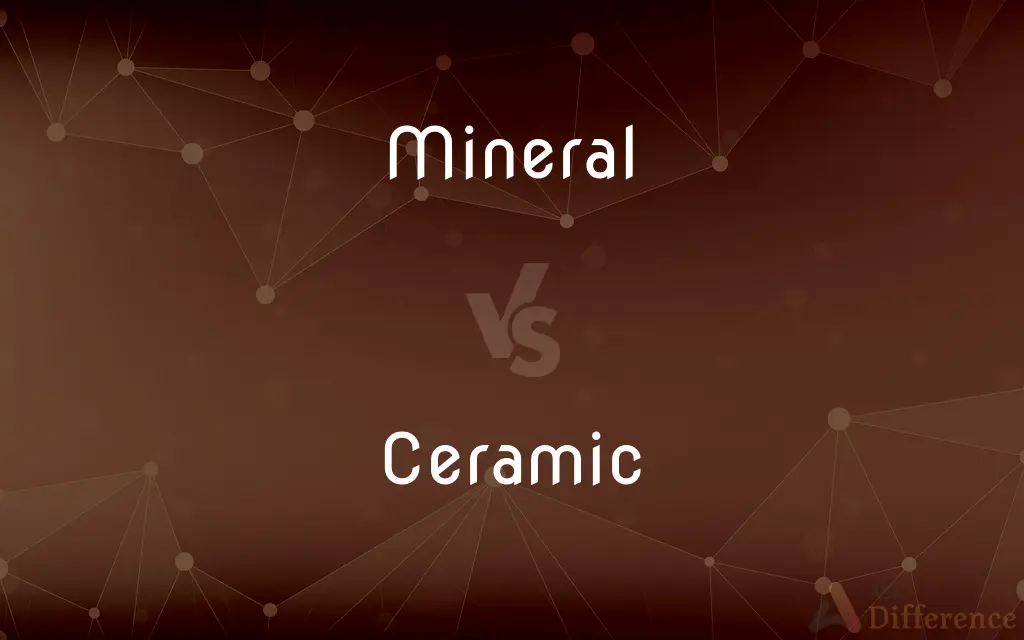Mineral vs. Ceramic — What's the Difference?
By Tayyaba Rehman & Fiza Rafique — Updated on May 2, 2024
Minerals are naturally occurring inorganic substances with a defined chemical composition, while ceramics are manufactured from non-metallic minerals by heating and subsequent cooling.

Difference Between Mineral and Ceramic
Table of Contents
ADVERTISEMENT
Key Differences
Minerals are naturally found in the earth and are characterized by a specific chemical composition and crystalline structure. On the other hand, ceramics are artificial materials, created through the process of heating and then cooling natural minerals and other substances.
The formation of minerals occurs through geological processes such as crystallization from magma or precipitation from solutions. Whereas ceramics are produced by human intervention, where natural materials like clay are shaped and fired at high temperatures to achieve desired properties.
Minerals are often identified by their hardness, color, luster, and cleavage properties. Conversely, ceramics are recognized for their hardness, thermal and electrical insulation properties, which make them suitable for various industrial applications.
While minerals can exhibit a range of optical and physical properties due to their natural formation processes, ceramics can be engineered to possess specific characteristics, such as high heat resistance or electrical conductivity, depending on their intended use.
In terms of utility, minerals are crucial in various industries as raw materials (e.g., quartz in glass making, lithium in batteries). In contrast, ceramics are widely used in industries like construction (tiles, bricks), electronics (insulators, substrates), and even in biomedical applications (dental implants, bone substitutes).
ADVERTISEMENT
Comparison Chart
Origin
Naturally occurring
Manufactured
Composition
Defined chemical composition
Varies, typically non-metallic minerals
Production Process
Geological processes
Heating and cooling of raw materials
Typical Properties
Hardness, color, luster
Hardness, thermal insulation, electrical insulation
Common Uses
Raw materials in industries
Construction, electronics, biomedical
Compare with Definitions
Mineral
Found in various forms, each mineral has unique properties like hardness and cleavage.
Diamonds, known for their hardness, are used in cutting tools.
Ceramic
Used for making durable goods, such as tiles and figurines.
Ceramic tiles are popular in home construction for their durability.
Mineral
A naturally occurring, inorganic solid with a definite chemical composition and a crystalline structure.
Quartz is a mineral composed primarily of silicon dioxide.
Ceramic
A non-metallic, inorganic material made by heating and subsequent cooling.
Porcelain is a ceramic made by heating materials like kaolin in a kiln.
Mineral
Minerals can be precious or semi-precious stones used in jewelry.
Rubies are valued for their color and rarity.
Ceramic
They are employed in electronics for their insulating properties.
Ceramic substrates are used in integrated circuits.
Mineral
Used widely in industrial applications due to their chemical and physical properties.
Talc is used in the production of talcum powder.
Ceramic
Biocompatible ceramics are used in medical implants.
Zirconia is used in dental implants due to its compatibility and strength.
Mineral
They are classified into groups based on their chemical composition.
Halides are minerals that contain a halogen element as the principal anion.
Ceramic
Ceramics have high heat resistance making them ideal for cookware and kitchenware.
Ceramic pots and pans distribute heat evenly.
Mineral
In geology and mineralogy, a mineral or mineral species is, broadly speaking, a solid chemical compound with a fairly well-defined chemical composition and a specific crystal structure that occurs naturally in pure form.The geological definition of mineral normally excludes compounds that occur only in living beings. However some minerals are often biogenic (such as calcite) or are organic compounds in the sense of chemistry (such as mellite).
Ceramic
A ceramic is any of the various hard, brittle, heat-resistant and corrosion-resistant materials made by shaping and then firing a nonmetallic mineral, such as clay, at a high temperature. Common examples are earthenware, porcelain, and brick.
Mineral
A naturally occurring, homogeneous inorganic solid substance having a definite chemical composition and characteristic crystalline structure, color, and hardness.
Ceramic
Made of clay and permanently hardened by heat
A ceramic bowl
Mineral
An element, such as gold or silver.
Ceramic
Pots and other articles made from clay hardened by heat
Many of the painted ceramics are of native manufacture
Mineral
An organic derivative, such as coal or petroleum.
Ceramic
Any of various hard, brittle, heat-resistant and corrosion-resistant materials made by shaping and then firing a nonmetallic mineral, such as clay, at a high temperature.
Mineral
A substance, such as stone, sand, salt, or coal, that is extracted or obtained from the ground or water and used in economic activities.
Ceramic
An object, such as earthenware, porcelain, or tile, made of ceramic.
Mineral
A substance that is neither animal nor vegetable; inorganic matter.
Ceramic
Ceramics (used with a sing. verb) The art or technique of making objects of ceramic, especially from fired clay.
Mineral
An inorganic element, such as calcium, iron, potassium, sodium, or zinc, that is essential to the nutrition of humans, animals, and plants.
Ceramic
Made of material produced by the high-temperature firing of inorganic, nonmetallic rocks and minerals.
A ceramic vase stood on the table.
Mineral
An ore.
Ceramic
(uncountable) A hard, brittle, inorganic, nonmetallic material, usually made from a material, such as clay, then firing it at a high tempature.
Joan made the dish from ceramic.
Mineral
Minerals Mineral water.
Ceramic
(countable) An object made of this material
Joe had dozens of ceramics in his apartment.
Mineral
A soft drink.
Ceramic
Of or pertaining to pottery; relating to the art of making earthenware; as, ceramic products; ceramic ornaments for ceilings.
Mineral
Of or relating to minerals
A mineral deposit.
Ceramic
An artifact made of hard brittle material produced from nonmetallic minerals by firing at high temperatures
Mineral
Impregnated with minerals.
Ceramic
Of or relating to or made from a ceramic;
A ceramic dish
Mineral
(geology) Any naturally occurring inorganic material that has a (more or less) definite chemical composition and characteristic physical properties.
Mineral
Any inorganic material (as distinguished from animal or vegetable).
Mineral
(nutrition) Any inorganic element that is essential to nutrition; a dietary mineral.
Mineral
(British) Mineral water.
Mineral
A soft drink, particularly a single serve bottle or can.
Mineral
(obsolete) A mine or mineral deposit.
Mineral
(obsolete) A poisonous or dangerous substance.
Mineral
Of, related to, or containing minerals
Mineral
An inorganic species or substance occurring in nature, having a definite chemical composition and usually a distinct crystalline form. Rocks, except certain glassy igneous forms, are either simple minerals or aggregates of minerals.
Mineral
A mine.
Mineral
Anything which is neither animal nor vegetable, as in the most general classification of things into three kingdoms (animal, vegetable, and mineral).
Mineral
Of or pertaining to minerals; consisting of a mineral or of minerals; as, a mineral substance.
Mineral
Impregnated with minerals; as, mineral waters.
Mineral
Solid homogeneous inorganic substances occurring in nature having a definite chemical composition
Mineral
Relating to minerals;
Mineral elements
Mineral deposits
Mineral
Of or containing or derived from minerals;
A mineral deposit
Mineral water
Decaying vegetable matter
Mineral
Composed of matter other than plant or animal;
The inorganic mineral world
Common Curiosities
What is the primary difference between minerals and ceramics?
The primary difference is that minerals are natural, inorganic substances with a fixed chemical structure, whereas ceramics are manufactured materials typically made from non-metallic minerals.
Why are ceramics preferred in high-temperature applications?
Ceramics are preferred in high-temperature applications due to their ability to withstand extreme heat without melting or decomposing, which is essential for applications like furnace linings and aerospace components.
What are some examples of minerals commonly used in ceramics?
Common minerals used in ceramics include kaolin (used in porcelain), feldspar (used in glassware), and quartz (used in various types of pottery).
How are minerals important to the economy?
Minerals are essential to the economy as they are the raw materials for many industries, including construction, manufacturing, technology, and energy production.
How do the properties of ceramics contribute to environmental sustainability?
Ceramics contribute to environmental sustainability through their durability and longevity, reducing the need for frequent replacement and offering sustainable building material options.
What are piezoelectric ceramics, and what are they used for?
Piezoelectric ceramics are materials that generate an electric charge in response to applied mechanical stress. They are commonly used in sensors, actuators, and ultrasound equipment.
Are all ceramics made from clay?
No, not all ceramics are made from clay; some are made from other inorganic, non-metallic materials like silicon carbide and alumina.
Can ceramics be naturally occurring?
While ceramics are generally manufactured, certain naturally occurring materials like obsidian (volcanic glass) are similar to ceramics in some of their properties.
Can minerals be synthetic?
While most minerals are naturally occurring, synthetic versions of various minerals, like synthetic diamonds or lab-created rubies, are also produced for specific industrial and jewelry applications.
What role do minerals play in the environment?
Minerals play crucial roles in the environment, including influencing soil composition and fertility, affecting water chemistry, and forming part of the natural geological processes of the Earth.
What is the significance of the crystalline structure in minerals?
The crystalline structure of minerals determines many of their physical properties, such as hardness, cleavage, and the way they break, which are important for identification and industrial applications.
How do cultural practices influence the use of ceramics?
Cultural practices significantly influence the use of ceramics, particularly in art and architecture, where ceramics have been used for millennia in pottery, tilework, and decorative arts, reflecting cultural heritage and aesthetic preferences.
Are ceramics recyclable?
Yes, many ceramics can be recycled, especially those used in construction and packaging. However, the recycling processes and facilities may vary depending on the type of ceramic and its use.
What advancements have been made in ceramic technology?
Recent advancements in ceramic technology include the development of bio-ceramics for medical implants, ceramic coatings for heat protection, and advanced ceramics used in semiconductor manufacturing.
What is the impact of mineral extraction on the environment?
Mineral extraction can have significant environmental impacts, including habitat destruction, water pollution, and soil erosion, necessitating careful management and rehabilitation practices.
Share Your Discovery

Previous Comparison
Power vs. PassionNext Comparison
Pel vs. PixelAuthor Spotlight
Written by
Tayyaba RehmanTayyaba Rehman is a distinguished writer, currently serving as a primary contributor to askdifference.com. As a researcher in semantics and etymology, Tayyaba's passion for the complexity of languages and their distinctions has found a perfect home on the platform. Tayyaba delves into the intricacies of language, distinguishing between commonly confused words and phrases, thereby providing clarity for readers worldwide.
Co-written by
Fiza RafiqueFiza Rafique is a skilled content writer at AskDifference.com, where she meticulously refines and enhances written pieces. Drawing from her vast editorial expertise, Fiza ensures clarity, accuracy, and precision in every article. Passionate about language, she continually seeks to elevate the quality of content for readers worldwide.
















































